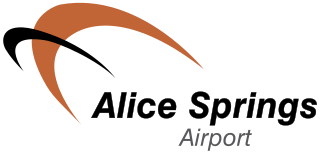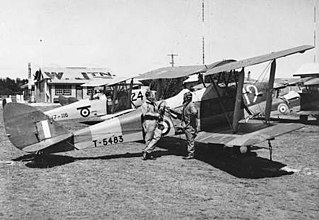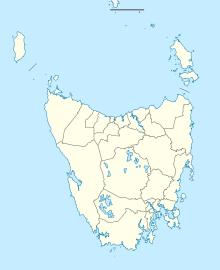
The de Havilland Express, also known as the de Havilland D.H.86, was a four-engined passenger aircraft manufactured by the de Havilland Aircraft Company between 1934 and 1937.

Hobart Airport is an airport located in Cambridge, 17 km (11 mi) north-east of the Hobart central business district. It is the principal airport of Tasmania.

Launceston Airport is a regional airport on the outskirts of Launceston, Tasmania. The airport is located in the industrial area of Western Junction, 15 kilometres from Launceston city centre. It is Tasmania's second busiest after Hobart.

Essendon Fields Airport, colloquially known by its former name Essendon Airport, is a 305 ha public airport serving scheduled commercial, corporate-jet, charter and general aviation flights. It is located next to the intersection of the Tullamarine and Calder Freeways, in the north western suburb of Essendon Fields of Melbourne, Victoria, Australia. The airport is the closest to Melbourne's City Centre, approximately an 11 km (6.8 mi) drive north-west from it and 8 km (5.0 mi) south-east from Melbourne–Tullamarine Airport. In 1970, Tullamarine Airport replaced Essendon as Melbourne's main airport.
Par Avion is a regional airline based in Hobart, Tasmania, Australia. It operates scheduled services across Tasmania and charter services. It owns and operates Cambridge Aerodrome, a flying training school which is affiliated with the University of Tasmania and a tourism business into the Southwest National Park, including day and overnight trips to Bathurst Harbour.
Rex Airlines Pty Ltd is an Australian regional airline based in Mascot, New South Wales. It operates scheduled regional services using turboprop aircraft. Between 2021 and 2024, Rex also operated jet services between selected major Australian cities. In July 2024 it was placed into voluntary administration.

Lauderdale is a town on the outskirts of Hobart, capital of Tasmania, Australia. The population of Lauderdale is approximately 2,592. It is in the local government area of City of Clarence. The town is situated on the eastern side of a thin isthmus that connects the South Arm Peninsula to the mainland. It faces Ralphs Bay, and the majority of Lauderdale's population live along Roches Beach, which faces Frederick Henry Bay. Along with nearby Seven Mile Beach, it is a popular residential area for people working in the Hobart CBD.

Strahan Airport is an airport located 2 nautical miles west of Strahan, Tasmania, Australia. It is the main airport for the West Coast of Tasmania, and is owned and maintained by the West Coast Council. The need for an airport in the area was suggested in the 1950s, and suggestions for upgrades have occurred over time.

Alice Springs Airport is an Australian regional airport 7 nautical miles south of Alice Springs, Northern Territory.

Burnie Airport, also called Burnie Wynyard Airport or Wynyard Airport, is a regional airport located adjacent to the town of Wynyard, about 17 kilometres (11 mi) west of Burnie, Tasmania, Australia. Formally named the Wynyard Aerodrome, the first official opening occurred on 26 February 1934. The Burnie Airport is majority owned by the Burnie City Council.

Bathurst Airport is an airport serving Bathurst, New South Wales, Australia.
Mudgee Airport is a regional airport located 3 nautical miles north northeast of Mudgee, New South Wales, Australia. The airport is frequently used for technical training. FlyPelican operates a flight to Sydney, making it the only commercial airline serving Mudgee.

Shellharbour Airport, formerly Illawarra Regional Airport, also referred as Albion Park Aerodrome or Wollongong Airport, is an airport located in Albion Park Rail, New South Wales, Australia.

Toowoomba City Aerodrome is an airport located 2.2 nautical miles northwest from the CBD of Toowoomba, Queensland, Australia. Toowoomba City Aerodrome is both licensed and certified. The aerodrome is owned and operated by Toowoomba Regional Council. Being certified means the airfield is able to have airlines and larger charter aircraft operate from the aerodrome. Being licensed means that the aerodrome is regulated by federal transport security regulations. Toowoomba City Aerodrome does not have a control tower; however the airfield is regulated and operated under Civil Aviation Safety Authority (CASA) regulations of aviation operations at non-tower controlled aerodromes.
Wilkins Aerodrome is a single-runway aerodrome operated by Australia, located on upper glacier of the ice sheet Preston Heath, Budd Coast, Wilkes Land, on the continent of Antarctica, but 40 km (25 mi) southeast of the actual coast. It is named after Sir Hubert Wilkins, a pioneer of Antarctic aviation and exploration.
The city of Hobart, Tasmania is served by a wide variety of transport. While the city's main form of transport is private transport on the road network, transport is also available by bus, ferry and aircraft. A suburban train service operated between Hobart and Brighton from the 1870s until 31 December 1974. There has been, however, talk in recent years of reinstating a train service in the northern suburbs.

On Sunday 10 March 1946 a Douglas DC-3 aircraft departed from Hobart, Tasmania for a flight to Melbourne. The aircraft crashed into the sea with both engines operating less than 2 minutes after takeoff. All twenty-five people on board the aircraft died. It was Australia's worst civil aviation accident at the time.

No. 7 Elementary Flying Training School was a Royal Australian Air Force (RAAF) pilot training unit that operated during World War II. It was established in August 1940 at Western Junction Aerodrome, Tasmania, and provided introductory flying training to new RAAF pilots. Training activities ceased in December 1944, and the unit was disbanded in August the next year.

Queenstown Airport is an aerodrome located at Howard's Plains west of Queenstown, Tasmania, Australia. Formerly a commercial airport, the aerodrome no longer receives regular passenger services, but is maintained by the West Coast Council for a variety of aviation and non-aviation related uses.
Vee H Aviation Pty Ltd, operating as Link Airways, formerly known as Fly Corporate, is an Australian regional airline based at Brisbane Airport, Queensland. The airline operates scheduled regional passenger services in Queensland, New South Wales, Victoria, Tasmania and the Australian Capital Territory. Link Airways operates a fleet of Saab 340B Plus and Fairchild Metro 23 turboprop aircraft.


















